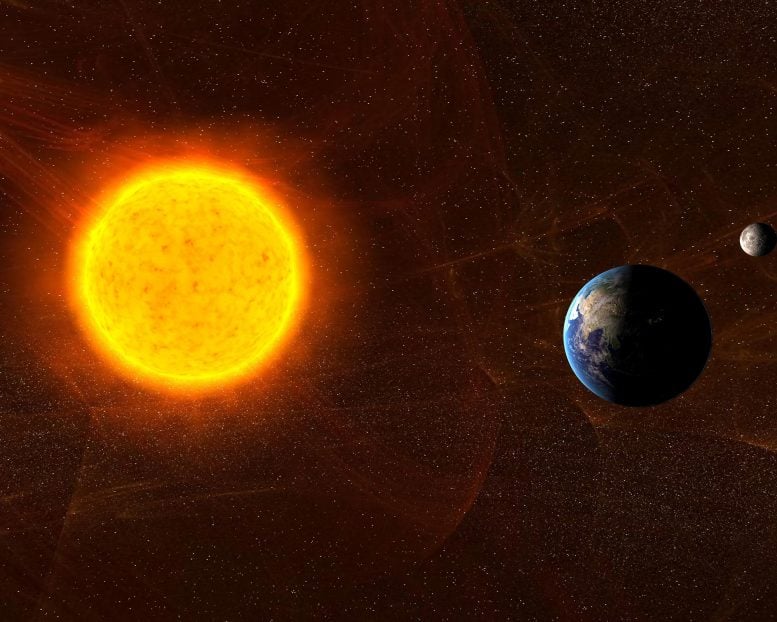
An analysis of observational data and a large climate model finds Earth’s 11-year cycle is out of sync with solar fluctuations.
The Earth’s global climate system fluctuates in 11-year and 3,5-year cycles find Yizhak Feliks, Justin Small, and Michael Ghil. The study was published in Climate Dynamics on July 15th. The 11-year near-periodicity recalls that of the solar cycle, which climate-skeptics for decades have argued plays a major role in global warming. But the fluctuations between the Earth’s climate system and the sun are out of sync, the study finds. The work, which is part of the European TiPES project coordinated from the University of Copenhagen thus refutes the climate skeptics’ claim of major solar effects on recent climate evolution.
A search for climate tipping
The main goal of the study was to address the debate about whether large and complex climate models can warn us about climate tipping. Climate tipping might have taken place in past climates. But current large state-of-the-art IPCC climate models seem to not capture intrinsic low-frequency fluctuations which lead to climate tipping. If correct, our models might not be able to predict upcoming tipping in the climate system due to the current global warming.
To search for low-frequency fluctuations, multichannel singular spectrum analysis was used. This method makes it possible to identify signals in noisy environments – like picking out and isolating the sound of a single musical instrument from a large symphonic orchestra.
Two frequencies
The analysis of two large observational data sets and an advanced state-of-the-art climate model, CESM showed that large climate models are capable of capturing low-frequency oscillations. The model agrees with observations in simulating the Earth’s two distinct low-frequency modes: One with a period of approximately 11 years, and another one lasting around 3,5 years.
This result, therefore, makes it less likely that the lack of climate tipping in complex climate models should be explained by the absence of low-frequency oscillations.
“It’s great to find a decadal cycle in an IPCC-class model like CESM. The failure so far of finding intrinsic decadal variability in the high-end IPCC climate models cast doubts on their reliability. Our work with Yizhak Feliks and Justin Small indicates that these doubts are on their way to being resolved,” says Michael Ghil, Ecole Normale Supérieure, Paris, France and UCLA, Los Angeles, USA.
Curves do not fit
The finding of the controversial near 11-year cycle prompted comparison between the cycles of the climate system and the Sun which climate sceptics have long argued can explain global warming.
The near 11-year cycles found in the large climate model and the two observational data sets in this study, however, are clearly out of sync with the Sun. The curves don’t fit. As such, the present study indicates the Sun’s fluctuations play little if any role in the current global warming.
“Solar-cycle effects on climate in general and global warming, in particular, have generated literally hundreds of articles in the scientific literature. No single paper, whether pro or con, will settle the debate for good. But our paper brings both a new point of view, from the synchronization theory of chaotic oscillators, and a possible resolution: Yes, there is a decadal climate cycle,” says Michael Ghil.
“But it is intrinsic to the climate system and out of sync with the actual solar cycle. This lack of synchronicity argues quite vigorously for the physical effects of the solar cycle on climate being quite weak, and thus of no real consequence for global warming,” states Ghil.
Reference: “Global oscillatory modes in high-end climate modeling and reanalyses” by Yizhak Feliks, Justin Small and Michael Ghil, 15 July 2021, Climate Dynamics.
DOI: 10.1007/s00382-021-05872-z
The TiPES project is an EU Horizon 2020 interdisciplinary climate science project on tipping points in the Earth system. 18 partner institutions work together in more than 10 countries. TiPES is coordinated and led by The Niels Bohr Institute at the University of Copenhagen, Denmark and the Potsdam Institute for Climate Impact Research, Germany. The TiPES project has received funding from the European Horizon 2020 research and innovation program, grant agreement number 820970.
"cycle" - Google News
November 22, 2021 at 06:19AM
https://ift.tt/3kTWCao
Can the Sun’s 11-Year Cycle Explain Global Warming? - SciTechDaily
"cycle" - Google News
https://ift.tt/32MWqxP
https://ift.tt/3b0YXrX
Bagikan Berita Ini
















0 Response to "Can the Sun’s 11-Year Cycle Explain Global Warming? - SciTechDaily"
Post a Comment